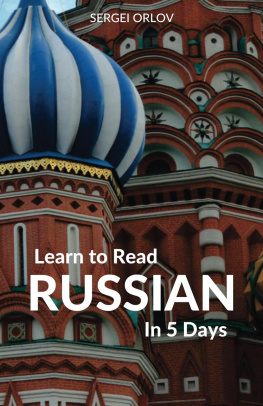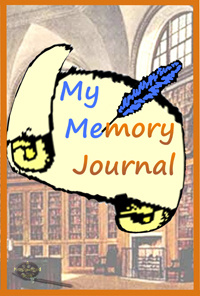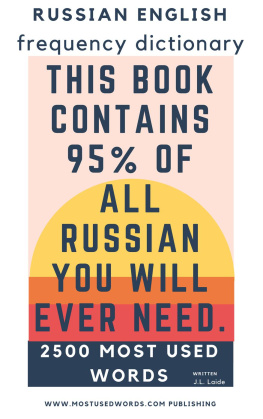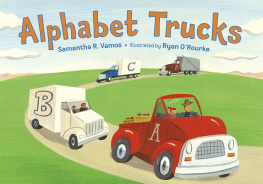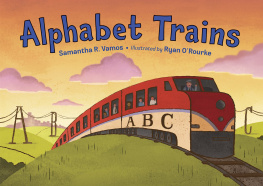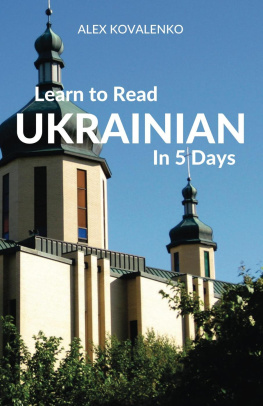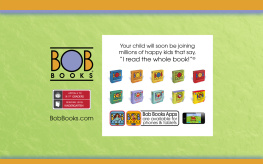Learn to Read Russian in 5 Days By: Sergei Orlov Published by Wolfedale Press Copyright 2015 All rights reserved. No part of this publication may be reproduced, distributed, or transmitted in any form or by any means, including photocopying, recording, or other electronic or mechanical methods, without the prior written permission of the publisher. The cover image of St. Basil's Cathedral in Moscow, Russia is licensed under cc by-sa 2.0. Author: michael clarke stuff www.wolfedalepress.com
TABLE OF CONTENTS
INTRODUCTION
L earning a new alphabet can be very intimidating for an English speaker only used to reading the Latin alphabet. This is partly why English speakers tend to stick to learning other languages that use the same alphabet, such as French, Spanish and Italian because they seem a lot easier! But learning a new alphabet does not have to be so difficult.
The difficulty is finding a good system to learn the new alphabet so that you dont get discouraged and give up before you make real progress. The secret to learning a new alphabet is to be taught how to pronounce each letter separately, and then to practice how the new letters combine with letters you already know to read real words in the alphabet in a structured way. This is not revolutionary it is probably how you learned to read English but it is not easy to find for other languages. This book will teach you how to read the Russian alphabet in exactly that way, and with this method you will be able to read Russian in only 5 days or less! After that you will be able to enjoy the Russian language and culture in a way that you were never able to before. THE RUSSIAN ALPHABET The Russian language uses 33 letters of the Cyrillic alphabet and is written from left to right. It uses the same basic alphabet as several other Slavic languages, including Ukrainian and Bulgarian, although there are differences in pronunciation between Russian and other languages that use the Cyrillic alphabet, just like there are differences in pronunciation between French, Spanish and English even though they use the same alphabet.
Although it does not closely resemble the Latin alphabet used to write English (and other European languages) it is not a difficult alphabet to learn to read. This is because, for the most part, letters are pronounced as they are written and written as they are pronounced, unlike languages such as English that make use of a lot of silent letters and historical spellings. Although correct Russian pronunciation can be difficult for English speakers, learning to read the alphabet is not as much as a challenge as it at first seems. Like the Latin alphabet used to write English, the Russian alphabet has both upper and lower case letters. Upper case letters are used at the beginning of a sentence and in proper nouns. HOW TO USE THIS COURSE The primary goal of this course book is to teach the reader to recognize the Russian alphabet and to begin to read the Russian language.
The main way this is accomplished is by teaching the individual pronunciations of each letter, and then utilizing Practice sections where the student can practice reading real Russian words. These Practice sections are very important and the main way the student will start to feel comfortable with the Russian alphabet. The answers to all Practice questions are included directly below the questions, but try to avoid looking at the answers until you have attempted to answer the questions yourself. Throughout the book, the reader will also learn approximately 150 real Russian words. These words have been carefully selected to be of maximum benefit to beginner students of the language and are a great starting point for students who want to continue their study of Russian. In the end of the book there are two glossaries one in thematic order and one in alphabetical order where the student can study and memorize all the words learned in this course.
The course material has been designed to be completed slowly over 5 days, while reviewing lessons as necessary. You are encouraged to go at whatever pace you feel comfortable with and to feel free to go back to lessons to review as much as needed. Good luck and I hope you enjoy the first step on your journey to learning the Russian language.
UNIT 1 - , , , ,
T he first 5 letters introduced in this course are the letters in Russian that resemble English letters and are pronounced roughly the same. Basically you already know these five Russian letters! The letter in Russian is pronounced like the a sound in the English words spa or father (IPA: /a/). The uppercase form is .
The letter is pronounced like the o sound in the English word hope (IPA: /o/) when stressed. When this letter is not stressed in a word, it is pronounced like the o in harmony which makes it basically the same as a Russian . The uppercase form is . The letter is pronounced like the k sound in the English words kick or kite (IPA: /k/). The uppercase form is . The letter is pronounced like the m sound in the English words mother or Michael (IPA: /m/).
The uppercase form is . The letter is pronounced like the t sound in the English words tan or Tom (IPA: /t/). The uppercase form is . As you can see these 5 letters are virtually the same as in English! PRACTICE Try to recognize these English words in their Russian disguises. The answers are below. at 2. cat 3. tack 4. coat 5. mat 6. mama
UNIT 2 - , , ,
T he four letters introduced in this unit look like English letters, but unlike Unit 1 these letters are not pronounced the same as in English. mama
UNIT 2 - , , ,
T he four letters introduced in this unit look like English letters, but unlike Unit 1 these letters are not pronounced the same as in English.
Pay close attention to these letters when reading Russian, as their similarity to letters in English make them an easy source of confusion. The letter is pronounced like the oo sound in boot, or the end of the word shoe. (IPA: /u/). It is not pronounced like the y sound in the English words yellow or tiny. The pronunciation will be represented by u in this book. The uppercase form is .
The letter is pronounced like the Spanish r sound in rapido, i.e. a trilled or rolled r sound (IPA: /r/). This letter is not difficult to pronounce for an English speaker but does require some practice. If you cannot pronounce this letter yet, you can substitute an English r sound for now. Although this letter resembles an English p it is not pronounced like a p sound. The uppercase form is .
The letter is pronounced like the s sound in some or same (IPA: /s/). Although it resembles an English c, it is never pronounced like the c in cat. It is always pronounced with an s sound. The hard c sound is spelled with in Russian. The uppercase form is . The letter is pronounced like the v sound in very (IPA: /v/).
Although this letter resembles an uppercase B, it is never pronounced like the English b sound in boy. The uppercase form is . PRACTICE Try to recognize these English words in their Russian disguises. Focus on the correct pronunciation and not necessarily the English spelling. The answers are below. rat 2. sat 3. room 4. cats 5. motor 6. moot 7. tomb 8. vast 9. stove 10. storm
UNIT 3 - , , ,
T he Russian letter , which looks like an uppercase N written backwards, is pronounced like the ee sound in bee or the i sound in spaghetti (IPA: /i/). storm
UNIT 3 - , , ,
T he Russian letter , which looks like an uppercase N written backwards, is pronounced like the ee sound in bee or the i sound in spaghetti (IPA: /i/).
The pronunciation will be represented by i in this book. The uppercase form is . The Russian letter is pronounced like the n sound in now or hen (IPA: /n/). Pay close attention to this letter as it resembles an uppercase H in English, but should not be pronounced with an h sound. The uppercase form is . The pronunciation of the Russian letter does not exist in English.
Next page
